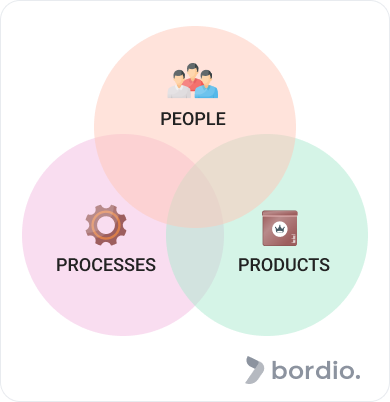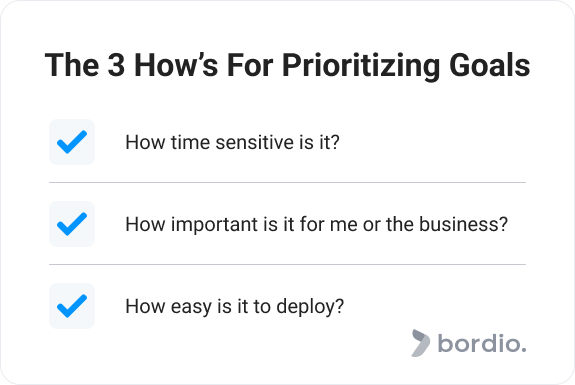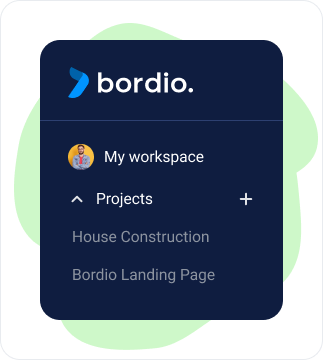New managers deal with a lot of emotions as they just join the company. They are excited to change the world of the organization they are working in, they are bursting with improvement, task organization and optimization ideas, they are eager to prove themselves and show how good of a manager they are.
At the same time, there is a lot of stress and uncertainty associated with a new job, especially a fresh management position, such as anxiety, imposter syndrome, stress, fear of failure.
One of the proven ways to support new managers in this tricky time is the 30 60 90 day plan.
It is a technique that helps structure the first crucial quarter in the company. It is sort of an action plan that guides managers through what needs to be paid attention to within the first 30 days, then the second and third months of employment.
Tip: All new managers can benefit from learning about different management styles. Some of them are better, and some of them are worse. Ultimately, each style has a lesson or two that can be taught to every one of us.
The key goals of the plan are to help the individual achieve the most within the timeframe and make a good impression on the team and the senior management. It helps stay focused, set the goals, work towards them, and, ultimately, succeed.
What is a 30 60 90 day plan?
The 30 60 90 day plan is a guideline for the first three months of the manager’s employment that can go along with the usual new hire training. It is usually created on the last stage of the interview process or in the first few weeks of employment.
The plan acts as a new employee’s north star that helps them reach main onboarding milestones and feel confident with their new job by the end of the third month. It also makes sure that the new manager’s goals align with what the company strives to achieve.
The plan drops down the 3 months into little sprints with actionable goals and targets, guaranteeing future success.
Some of the main goals of the 30 60 90 day plan include:
- Getting to know the team.
- Making the right first impression.
- Making your mark.
- Positioning yourself as a leader.
- Defining the future scope of work.
The three key elements of focus in the 30 60 90 day plan are the 3 Ps:
- People
- Processes
- Products
The plan is practiced by thousands of people allowing them to jump into a completely foreign environment and emerge as a fully functioning managers by the end of the onboarding period.
Tip: Starting a new job is always hard, especially with a leadership position. The stress can easily throw you off, so to get back in shape or to stay in control, it’s good to keep in touch with someone who can listen to you and mentor you a little bit. Alternatively, there are many useful resources online, such as tips for learning faster, articles on how successful people plan their days, and all about managing a remote team. Keep your mind busy with consuming new information to be less distracted by stress and anxiety in the new role.
First 30 days
The first 30 days are for adjusting to the new role’s learning curve, making impressions, and getting to know the team and the environment.
The main task for this period is to build healthy communication and develop relationships with the team.
Building relationships can be tricky in the office setting. If you are not sure where to start, here are some topic ideas that we recommend covering during your first catch-ups:
- Occupation right now and before.
- Professional strengths and weaknesses.
- Career goals and motivation.
- Perception of the current state of things in the team, company, or industry.
- Personal life – hopes and dreams, family, hobbies.
- Fun and crazy stories from your professional life.
Pro-tip: don’t be too serious all the time. Joking and casual chats help relax into the conversation and have a genuine talk. If you’re not sure how to ease up, check out our list of icebreakers that work great for online and in-person meetings.
The second goal is absorbing all information and vibes. Ask everyone to share their feedback, current issues, insight into some patterns within the company. Observe the team’s work style and the company’s culture code. Read between the lines, listen to how people talk about specific things to catch the subliminal messages.
The third goal is to make a small change to build trust and credibility with the team and to show your management that you are making progress. We recommend making a change associated with feedback or complaint you received from somebody in the team.
Gently challenge the current status quo. Bring in the new perspective, question established beliefs, and your own team’s processes.
At the same time, don’t rush getting to execution and decision-making. You will have all the time of the world later to be a manager at your new job, but now your focus should be on different things.
30 to 60 days
The second period of the 30 60 90 day plan is the time to dig deeper and become more active. By the end of the second month, the new manager should have a vision and a preliminary plan of action.
During this time, it is recommended to run evaluations (for example, SWOT) and analyze the team’s existing strategy to strengthen the understanding of the current situation within the team and organization as a whole.
Make another change – big or small – associated with something that you’ve uncovered within the second 30 days. Show the team and your boss that you are not just messing around, asking questions, and playing with business techniques, but there is a purpose to everything you do and everyone receives value from it.
By the end of the period, you should have proven to the team and your management that you can contribute to the overall success and you are ready to start making and implementing decisions.
Also, it is during the second month that you should determine the top goals to knock out this year in the time planner calendar. We recommend using Bordio’s free to-do list as a single point for all your goals (big and small), as well as observations. Bordio is very handy in this regard with their weekly schedule planner and daily schedule planner.
How to write goals during your second month in the company
Everybody’s goal planning process looks different. Here are a few tips to help you deal with the process efficiently and effectively.
1. Identify the businesses’ key needs and targets and keep them in mind. Look at the annual targets and goals that are shared with you. But also consider things like the company’s mission.
2. Assign all goals to different categories:
- Performance goals – what targets do you want to achieve. For example, execute 10 campaigns with the social media team.
- Learning goals – being in the know is so important for managers and all employees in general, so learning more about industry, company, new skills is key.
- Initiative goals – something you would like to introduce to the company, like a new strategy or methodology to support the company’s growth and improve performance. For example, you want to introduce a new cooperation process with the sales team or new marketing initiatives to get more leads from your core target audience. Mentioning marketing one cannot help but think of the fact that one can take the help of a digital marketing agency for startup.
- Personal goals – what are your goals outside of the core job responsibilities. Things like building rapport with somebody in the company, finding a mentor, or even becoming one.
It is vital to be growing on a professional and personal level together, not just focusing on business for 6 months, and then switching it up.
3. Prioritize the goals and classify them across the next 12 months. How do you prioritize? Look at:
- Time sensitivity.
- Importance to you or the business.
- Ease of deployment.
Then use online time manager to add prioritized tasks.
Tip: Don’t wait for too long to act on the goals you defined. Use Bordio’s calendar planner online to create first tasks and time blocks to work on the targets that you’ve set up for yourself and the team. With Bordio’s weekly schedule maker free your team will be aware of their tasks anytime.
4. Estimate what kind of resources and how many of them your goals will require. Remember to get resource approval to complete your plans before you start executing them.
By the way, if you’d like to learn more about goal setting and other productive habits, check out the Productivity Tips Everyone Needs to Adopt article on our blog.
60 to 90 days
The final part of the 30 60 90 day plan is all about finalizing what was started earlier and making the last adjustments to personal goals and professional plans.
At this point, the new manager needs to put the final touches on the analysis they’ve started earlier. Put everyone’s commentary and insight together, add your perceptions now after you’ve been with the company for a while. By the end of this exercise, there should be a list of tasks that have to be sorted.
Here, we recommend using the impact analysis to prioritize all tasks in a way that encourages you to concentrate on work that takes the least effort and generates the most reward, slowly moving towards more complicated and least rewarding activities.
Impact analysis resembles the Eisenhower matrix but it uses slightly different criteria: level of impact and ease of completion. For example, a task can have a high impact and take little effort to complete, or have a high impact and be difficult to complete.
Now is also the time to be more active during meetings, and to start making more decisions and suggesting new ideas to elevate the working process and help the team achieve their targets.
Tip: Check out the guide on maintaining and boosting accountability in the hybrid team with tips that are also applicable to the fully remote or in-office teams. Speaking of which – it will be much easier to work in a team with convenient remote workforce management software.
By the end of the 90 days period, you should have already established yourself as a leader who is able to do planning online and will be respected and trusted.
All the boxes should be ticked:
- You understand your role and responsibilities fully.
- Work culture and inner team dynamics are clear to you.
- You are familiar with everyone on the team, but also senior management and all key stakeholders.
- You are perceived as a leader and everyone is comfortable with sharing their thoughts or ideas with you.
- You work and collaborate with other teams on cross-related projects and tasks.
- You have regular meetings scheduled with all team members.
- Your personal goals within the career field are being worked on.
- There is a summary of your first 3 months in the company that you can share with your boss or hiring manager.
Bonus tip 1: For extra credit from your hiring manager, or to ease your onboarding, include a pre-start section to your 30 60 90 day plan.
There, you can plan for getting acquainted with company guides or handbooks, documentation, industry nuances before starting the new job. It is also good to run your own competitive research to make sure you get the most objective view on where the company stands in the market. This bit of extra time dedicated to researching and learning can help ease the anxiety and stress of the first days immensely.
Additionally, you will demonstrate your commitment and serious intentions about the job. But please don’t spend too much time on that as, after all, you have not yet officially started working and your personal time is very valuable too.
Bonus tip 2: Set up your own performance metrics.
Your company no doubt has an onboarding and a professional development plan for you. But those plans rarely match your personal goals 100%. So, if you want to make sure you are moving in the right direction long-term, set up your own KPIs in addition to the company’s key performance metrics. Create regular check-ins in your weekly planner online to track your progress. Whether you share your personal goals with the management or not is completely up to you.
Final thoughts on 30 60 90 plan For managers
A new job creates just as much fear as it does excitement. Yet, with a structured plan in place, new managers can power through this stressful time and have great results in the end.
A good 30 60 90 day plan can do wonders for a new manager’s adaptation in the organization. It helps run a smooth transition from a new team member to an important component of the company and a key contributor to its success.
The plan itself is not set in stone and can be changed and altered to meet one’s specific situation and requirements. The key to having a successful plan is to make it gradual. Yes, time is money and there is always so much to do, but the smart 30 60 90 day plan will ensure a comfortable pace that allows healthy immersing into the new environment.
The right software can make a huge difference in this process, so if you are looking for a single tool for personal and professional goals, then Bordio’s daily planner might be just for you.
Bordio allows separation between work and personal projects, has a convenient calendar view with timers and time blocks to assist with the planning and execution of the tasks. The waiting list is a perfect place for all ideas that you want to bring to life but didn’t schedule yet. Bordio’s simple task maker is perfect for productive work and staying on top of all your goals, plans, and deadlines.










